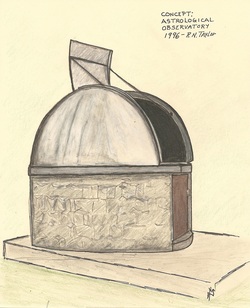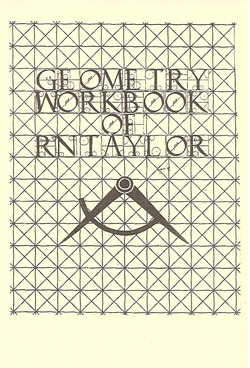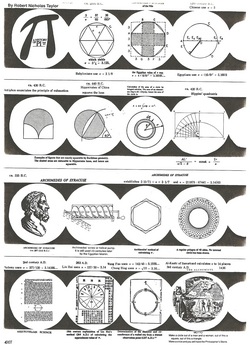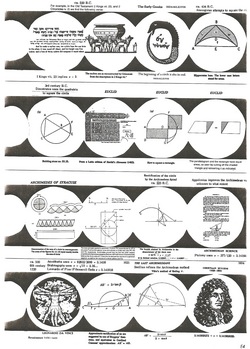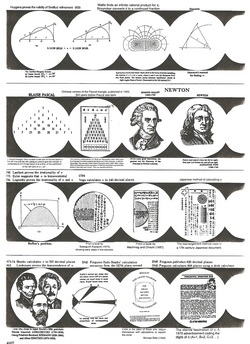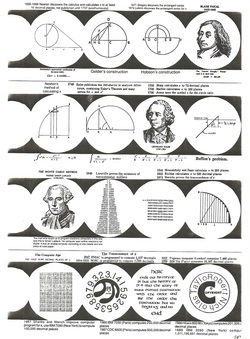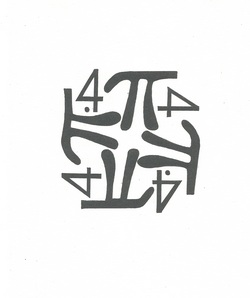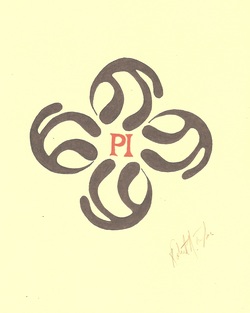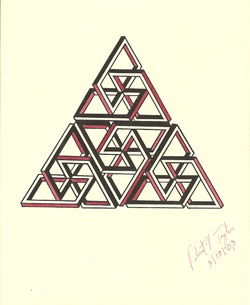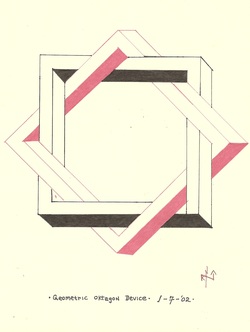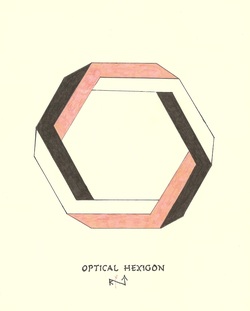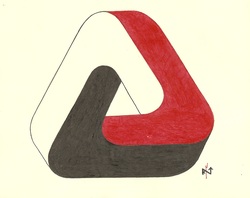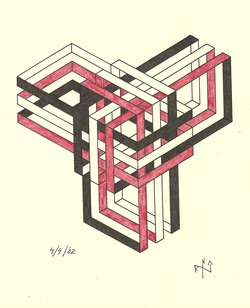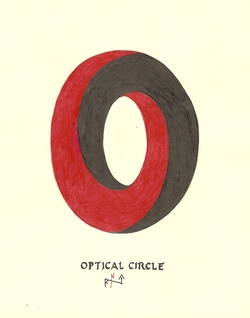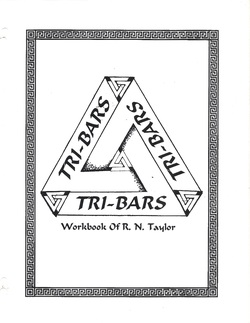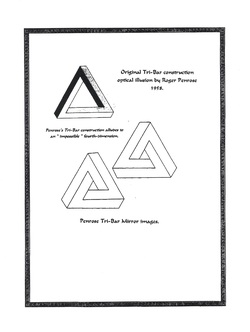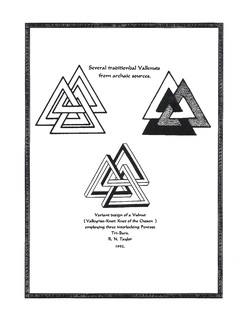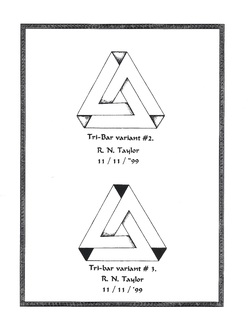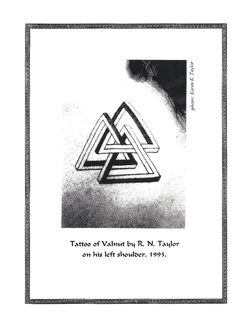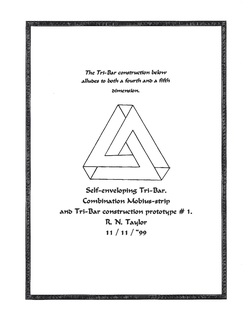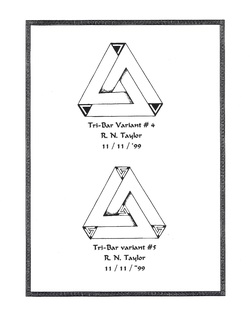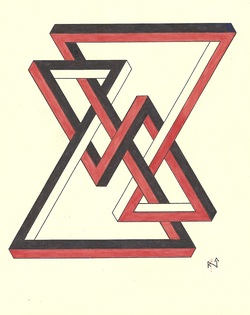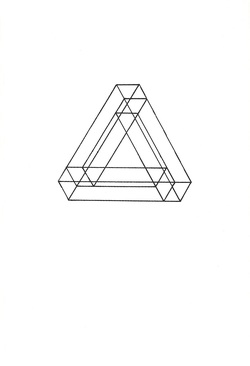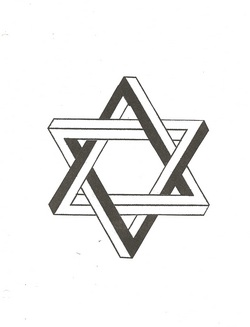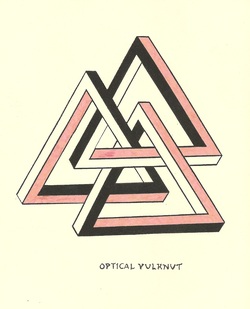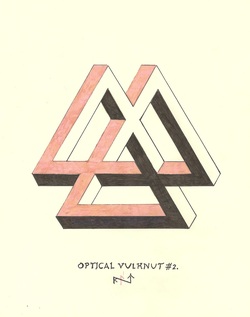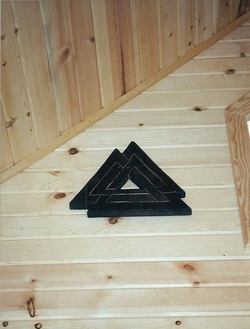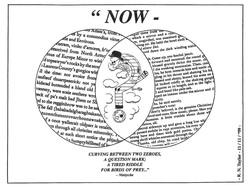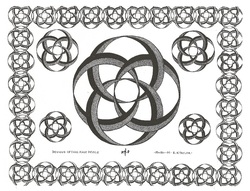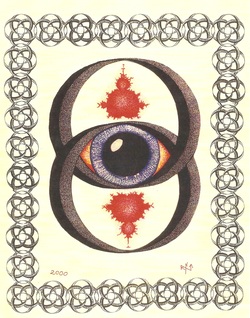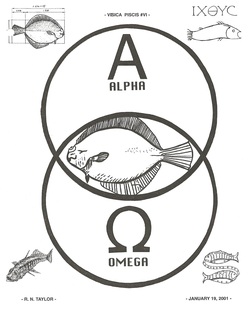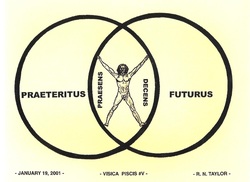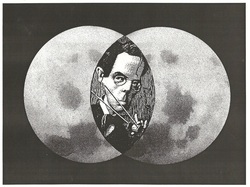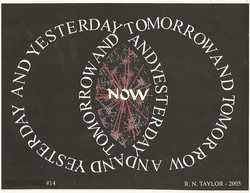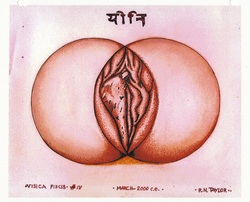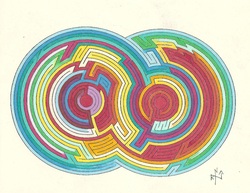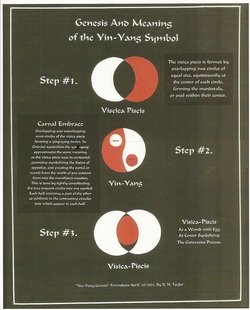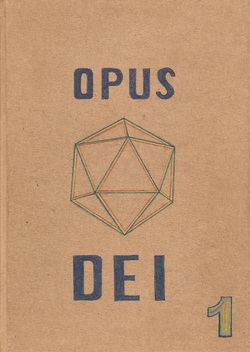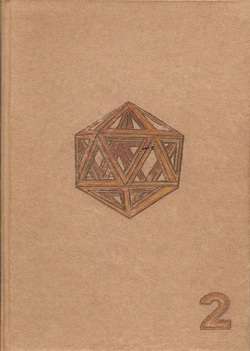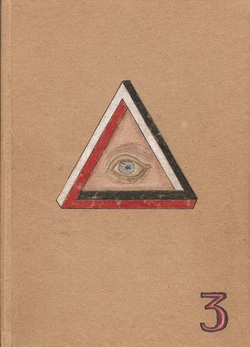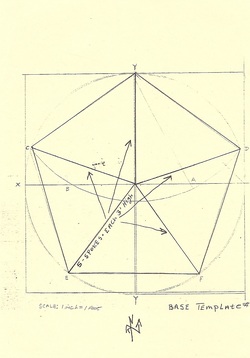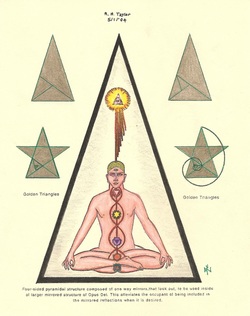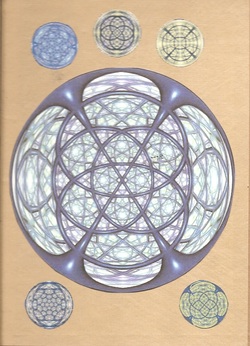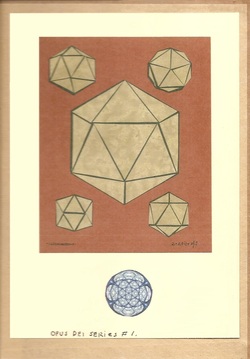Geometry
My interest and study of geometry was an offshoot of my longtime interest in astronomy. My father introduced me to astronomy at about twelve years old. We had a large telescope, inexpensive, about 6 feet long, and made of card board tubes that fit together, and it was mounted upon an old ladder. In those days you could still see the stars clearly, even in the city before light pollution came to be in the form of lamps which began to appear in every nook and cranny of the city. I can still recall taking my first look at the pristine rings wrapped around the planet Saturn. With that experience I was sold on astronomy. We spent many a summer night in our back yard late into the night star-gazing. My father was very adept at finding just about anything that he wanted to locate in the sky.
In my forty-third year I wished to return to astronomy as a pastime but with a more serious intent. I was at the time living on an eighty-plus acre farm on an island in Lake Michigan. It was a near perfect setting for an astronomical observatory. I had a 14-foot reinforced concrete slab laid in the middle of a large pasture. I had walked around the property for many a night trying to select the best location, a position which would afford me the greatest view of the sky. The observatory was to be constructed of concrete blocks rising up to 6-foot in height. Running along this would be a channel housing 144 golf balls as bearings on which a silo top could be rotated. I got the idea of painting a mural on the inside wall starting on the left hand side of the entrance and wrapping around to the right side. It would be a timeline of astronomy. I was inspired by an astronomy timeline that my longtime friend and artist George Petros had done for the magazine EXIT which he edited and published. In regards to the timeline, I would do what was necessary to determine just how many linear feet would be necessary for the wall. I planned to do my sketches on paper first before doing it in air brush on the concrete wall. I needed the Pi equation to get the right measurement since the observatory was to be a circular building. I recalled I had a volume on my shelf of the combined books of Archimedes and Euclid. I quickly found what I was looking for. But in looking at the book I began to grow interested in the geometric propositions posited.
In my youth the mere mention of math or geometry made me want to run in the other direction. They were subjects which intimidated me and which I found of no interest. Numbers seemed like dead matter. Geometry appeared as something I would never have useful application for. How short sighted I had been.
So, having cracked open that book on the rudiments of geometry was to have a long-ranging effect for me. I recall sitting up late till night filtered into dawn with compass and rule and drawing board working out various propositions. That winter seemed a very long one. It was the first winter I had spent living in such remoteness. The snow piled high and the days seemed a brief interlude, and one had the feeling of existing in a realm of near perpetual night. Throughout that winter I began a systematic study of the books of Archimedes and Euclid. In time this led to an interest in prime numbers and other areas of math and geometry. Moebius strips, Klein bottles, golden ratios t-bars and topography, magic squares and game boards and probability theories.
My studies broadened my knowledge in other areas of inquiry as well: symbolism, alchemy, musical theory, proportioning, botany, chemistry, and neurology. It helped to provide entirely new glances and perspectives into these and other fields of interest. It was time well spent.
That which I learned and pondered on was integrated and employed in various ways. Golden ratio was used in the building of sacred structures. Painting and graphic art drew heavily on such things as well.
The more arcane area of optical illusions and graphic art were also informed by these studies. A whole new realm had opened for me. I even composed a short musical theme as a background to a poetry reading which was an augmented pentatonic scale. The poem was titled “Star” (see a typographical rendering of the poem in the “Typographical Devices” section of this site).
I had always been a great admirer of Dutch graphic artist M.C. Escher and had marveled over his employment of geometry in most all of his work.
All of this was nearly 25 years ago as I write this today. I am still studying and pondering geometrical art, and I am still employing this knowledge in various ways in my creative endeavors. It has been a long path, and one which I will try to chronicle here in both word and graphic example.
-R. N. Taylor,
3/14/11
In my forty-third year I wished to return to astronomy as a pastime but with a more serious intent. I was at the time living on an eighty-plus acre farm on an island in Lake Michigan. It was a near perfect setting for an astronomical observatory. I had a 14-foot reinforced concrete slab laid in the middle of a large pasture. I had walked around the property for many a night trying to select the best location, a position which would afford me the greatest view of the sky. The observatory was to be constructed of concrete blocks rising up to 6-foot in height. Running along this would be a channel housing 144 golf balls as bearings on which a silo top could be rotated. I got the idea of painting a mural on the inside wall starting on the left hand side of the entrance and wrapping around to the right side. It would be a timeline of astronomy. I was inspired by an astronomy timeline that my longtime friend and artist George Petros had done for the magazine EXIT which he edited and published. In regards to the timeline, I would do what was necessary to determine just how many linear feet would be necessary for the wall. I planned to do my sketches on paper first before doing it in air brush on the concrete wall. I needed the Pi equation to get the right measurement since the observatory was to be a circular building. I recalled I had a volume on my shelf of the combined books of Archimedes and Euclid. I quickly found what I was looking for. But in looking at the book I began to grow interested in the geometric propositions posited.
In my youth the mere mention of math or geometry made me want to run in the other direction. They were subjects which intimidated me and which I found of no interest. Numbers seemed like dead matter. Geometry appeared as something I would never have useful application for. How short sighted I had been.
So, having cracked open that book on the rudiments of geometry was to have a long-ranging effect for me. I recall sitting up late till night filtered into dawn with compass and rule and drawing board working out various propositions. That winter seemed a very long one. It was the first winter I had spent living in such remoteness. The snow piled high and the days seemed a brief interlude, and one had the feeling of existing in a realm of near perpetual night. Throughout that winter I began a systematic study of the books of Archimedes and Euclid. In time this led to an interest in prime numbers and other areas of math and geometry. Moebius strips, Klein bottles, golden ratios t-bars and topography, magic squares and game boards and probability theories.
My studies broadened my knowledge in other areas of inquiry as well: symbolism, alchemy, musical theory, proportioning, botany, chemistry, and neurology. It helped to provide entirely new glances and perspectives into these and other fields of interest. It was time well spent.
That which I learned and pondered on was integrated and employed in various ways. Golden ratio was used in the building of sacred structures. Painting and graphic art drew heavily on such things as well.
The more arcane area of optical illusions and graphic art were also informed by these studies. A whole new realm had opened for me. I even composed a short musical theme as a background to a poetry reading which was an augmented pentatonic scale. The poem was titled “Star” (see a typographical rendering of the poem in the “Typographical Devices” section of this site).
I had always been a great admirer of Dutch graphic artist M.C. Escher and had marveled over his employment of geometry in most all of his work.
All of this was nearly 25 years ago as I write this today. I am still studying and pondering geometrical art, and I am still employing this knowledge in various ways in my creative endeavors. It has been a long path, and one which I will try to chronicle here in both word and graphic example.
-R. N. Taylor,
3/14/11
Pi
Text coming soon.
Coloration
In the realm of graphic arts, there is a long unresolved debate concerning color. Graphic art is overwhelmingly an art of black and white. For the graphic artist, the white can never be white enough and similarly so with the black. Add to this the intermediate shades of grey. This is basically what the graphic artist works with.
Beyond the medium of black and white is the application of these grey tones, the balance and calculated artistry as to how they are to be used with one another in degree as well as in distribution.
Grey is often the only shade of resolution in something that is otherwise irresolvable (see the Typographical Devices section of this gallery for the graphic “Paradox”). In the case of tri-bars and other images that rely upon the basic principle of impossible perspective, there is a need for three distinct tones so as to delineate the separate angles of the bars and create the visual paradox that they are intended to be.
From an aesthetic point I choose to use red as the third color in the triad. There are other triads of color that I like, but less so, such as green, orange (or yellow) and purple - but the color combination of red, white and black have a long history among Indo-Europeans. They might be said to be the ultimate Indo-European color triad. One could cite many examples of art and artifact as well as literature to prove the point.
I personally like the combination. It resonates with me on an inner plane. So that is the principle reason for my choice of these colors for my geometric art that necessitates such a division of color.
-R. N. Taylor,
4/4/11
Beyond the medium of black and white is the application of these grey tones, the balance and calculated artistry as to how they are to be used with one another in degree as well as in distribution.
Grey is often the only shade of resolution in something that is otherwise irresolvable (see the Typographical Devices section of this gallery for the graphic “Paradox”). In the case of tri-bars and other images that rely upon the basic principle of impossible perspective, there is a need for three distinct tones so as to delineate the separate angles of the bars and create the visual paradox that they are intended to be.
From an aesthetic point I choose to use red as the third color in the triad. There are other triads of color that I like, but less so, such as green, orange (or yellow) and purple - but the color combination of red, white and black have a long history among Indo-Europeans. They might be said to be the ultimate Indo-European color triad. One could cite many examples of art and artifact as well as literature to prove the point.
I personally like the combination. It resonates with me on an inner plane. So that is the principle reason for my choice of these colors for my geometric art that necessitates such a division of color.
-R. N. Taylor,
4/4/11
Tri-Bars
The invention of the tri-bar is attributed to British mathematician Roger Penrose. I first became aware of Penrose and his tri-bar in the book The Graphic Work of Escher (Ballantine Books, 1969)and The Magic Mirror of M.C. Escher by Bruno Ernst(Ballantine Books, 1976). Escher had taken Penrose’s tri-bar principle and applied it to representational art in his works “Belvedere”and “Waterfall”and other graphics.
In its basic tri-bar configuration it alludes to a not quite graspable fourth dimension. It is in fact a visual impossibility and a paradoxical form as a result, and a trick upon the human visual/neurological apparatus.
This essential principle can be applied in many geometrical as well as representational ways. Escher above all forged the path in art of taking geometry and applying it to representational art. His body of work pretty much covers this area of geometry and much more. My own interest in such tri-barbased art is that it deals with paradox. It has long been my thought that paradox will be found in any field of endeavor which approaches the concept of infinity (theology, mysticism, physics, philosophy, et al.). I believe that the paradoxical end product is built into the creation as a defense mechanism against intelligent life such as us. The creation does not want us to know so much that we will, in our oftentimes perverse manner, find answers and principles that will facilitate our destroying the creation in some way. Molecular as well as genetic sciences pose this threat. Man may find knowledge but seldom has the wisdom in the manner in which he uses it - hence, paradox. The reader will find several graphics I’ve done which address paradox on the typographical page, “Infinity” and also “Paradox”(in the typographical section). Often art I have done can be classified under more than one subject heading such as “Architecture of a Maple Leaf” and “Geometry of a Sunflower” (either of which could find a place in the botanical section as well as the geometrical). Likewise with the fields of symbolism and geometry, often the two overlap into one another. Viewers will have to keep that in mind as they visually stroll through this gallery.
As for tri-bars, I pretty much had exhausted my approach and interest in them by 1999. The only thing I have not done is, as Escher did, employ such principles in representational artwork as opposed to simple geometric shapes. Perhaps I am yet to do so?
And as for innovation, the only innovation I may have added to the tri-bar is a combined tri-bar/Moebius strip, combining them into an allusion not only of a fourth dimension but also a fifth dimension.
Geometry and symbols have been worked over by generations of intelligent and gifted individuals. It is seldom that anyone can in fact add anything much to them. Often, as I have found in the case of symbols, one finds what they believe to be a new play upon something only to discover that they have in a sense re-invented the wheel as the saying goes. It already existed.
I feel one should always be looking for new applications as well as plays upon such things. Innovation and creativity is what keeps something alive and vibrant.
-R.N. Taylor,
3/14/11
In its basic tri-bar configuration it alludes to a not quite graspable fourth dimension. It is in fact a visual impossibility and a paradoxical form as a result, and a trick upon the human visual/neurological apparatus.
This essential principle can be applied in many geometrical as well as representational ways. Escher above all forged the path in art of taking geometry and applying it to representational art. His body of work pretty much covers this area of geometry and much more. My own interest in such tri-barbased art is that it deals with paradox. It has long been my thought that paradox will be found in any field of endeavor which approaches the concept of infinity (theology, mysticism, physics, philosophy, et al.). I believe that the paradoxical end product is built into the creation as a defense mechanism against intelligent life such as us. The creation does not want us to know so much that we will, in our oftentimes perverse manner, find answers and principles that will facilitate our destroying the creation in some way. Molecular as well as genetic sciences pose this threat. Man may find knowledge but seldom has the wisdom in the manner in which he uses it - hence, paradox. The reader will find several graphics I’ve done which address paradox on the typographical page, “Infinity” and also “Paradox”(in the typographical section). Often art I have done can be classified under more than one subject heading such as “Architecture of a Maple Leaf” and “Geometry of a Sunflower” (either of which could find a place in the botanical section as well as the geometrical). Likewise with the fields of symbolism and geometry, often the two overlap into one another. Viewers will have to keep that in mind as they visually stroll through this gallery.
As for tri-bars, I pretty much had exhausted my approach and interest in them by 1999. The only thing I have not done is, as Escher did, employ such principles in representational artwork as opposed to simple geometric shapes. Perhaps I am yet to do so?
And as for innovation, the only innovation I may have added to the tri-bar is a combined tri-bar/Moebius strip, combining them into an allusion not only of a fourth dimension but also a fifth dimension.
Geometry and symbols have been worked over by generations of intelligent and gifted individuals. It is seldom that anyone can in fact add anything much to them. Often, as I have found in the case of symbols, one finds what they believe to be a new play upon something only to discover that they have in a sense re-invented the wheel as the saying goes. It already existed.
I feel one should always be looking for new applications as well as plays upon such things. Innovation and creativity is what keeps something alive and vibrant.
-R.N. Taylor,
3/14/11
The Valknut
The word valknut is a Norse word meaning Valkyries Knot and describes a symbol which is composed of three interlocking triangles.
The points of these triangles are nine in number symbolizing the Nine Worlds of the universe. Another meaning of the symbol is Knot of the Chosen. This alludes to those heroes chosen in battle by theValkyries (Odin’s shield maidens).
There are, as in all symbolism, many other meanings - some quite sinister. Often displayed on the shields of warriors were the interlocking triangles forming what could act to scramble an opponent’s sight or transfix his attention long enough to miss a beat in battle and be defeated.
At some point, for some reason I modified the traditional valknut using three interlocking Penrose optical tri-bars. If a valknut could confuse another, then certainly the paradoxical tri-bar of Penrose thrice repeated and interlocked might take the visual confusion to another level.
Eventually I was to have this configuration tattooed on the back of my shoulder. In fact, it was the very first of seven tattoos I would acquire.
Tattooing straight lines, such as in geometry, requires a very experienced and steady hand, and an ultra-focused tattoo artist. Once imprinted on the back, the lines must be done freehand. I was fortunate to have a tattooist with the requisite skills to do it properly: Rick Harnowski of Green Bay, Wisconsin.
As one into the belief system of Asatru (the resurrected native faith of Germanic people), the valknut had symbolic meaning for me. In having it gravened on my skin I was in effect stating that I was ready to meet my fate any time it should confront me with stalwart courage and fortitude. Besides the use of the valknut in my tattoo and tri-bar variations, I also made one out of a single piece of wood as a part of the décor inside an Asatru temple which I designed and built. I would have classified this work under symbols, save for the fact that the tri-bar was in fact employed.
-R.N. Taylor,
3/14/11
The points of these triangles are nine in number symbolizing the Nine Worlds of the universe. Another meaning of the symbol is Knot of the Chosen. This alludes to those heroes chosen in battle by theValkyries (Odin’s shield maidens).
There are, as in all symbolism, many other meanings - some quite sinister. Often displayed on the shields of warriors were the interlocking triangles forming what could act to scramble an opponent’s sight or transfix his attention long enough to miss a beat in battle and be defeated.
At some point, for some reason I modified the traditional valknut using three interlocking Penrose optical tri-bars. If a valknut could confuse another, then certainly the paradoxical tri-bar of Penrose thrice repeated and interlocked might take the visual confusion to another level.
Eventually I was to have this configuration tattooed on the back of my shoulder. In fact, it was the very first of seven tattoos I would acquire.
Tattooing straight lines, such as in geometry, requires a very experienced and steady hand, and an ultra-focused tattoo artist. Once imprinted on the back, the lines must be done freehand. I was fortunate to have a tattooist with the requisite skills to do it properly: Rick Harnowski of Green Bay, Wisconsin.
As one into the belief system of Asatru (the resurrected native faith of Germanic people), the valknut had symbolic meaning for me. In having it gravened on my skin I was in effect stating that I was ready to meet my fate any time it should confront me with stalwart courage and fortitude. Besides the use of the valknut in my tattoo and tri-bar variations, I also made one out of a single piece of wood as a part of the décor inside an Asatru temple which I designed and built. I would have classified this work under symbols, save for the fact that the tri-bar was in fact employed.
-R.N. Taylor,
3/14/11
Vesica Piscis
My interest and the application in my art and geometric exercises of the vesca piscis came about in a rather dramatic and protein manner. I have often had inspiration in sleeping dreams, hypnogogic vision and with the use of psychoactive drugs. This was a case of the latter.
As I recall, I had been up all night writing an article. Often if one has been at such a task as painting a picture (particularly long interludes of edging with a fine sable brush) or writing in excess, they discover that they cannot turn the process off. Even as one tries to get to sleep, the mind continues to serve up witty phrases and dissertations. Same with painting. You close your eyes and you continue to paint with a brush over and again.
I hit one of those junctions after a long stint at writing. I could think of nothing on hand which would relax or put me to sleep. Cannabis is something that makes one restful and drowsy. Various sedatives I am sure will do the same in that regard. I had none of these things that early morning in January.
I thought of herbal tea or something warm to eat like noodles or rice. That usually made me a bit drowsy. Then I recalled that in my solarium I had three potted plants of Salvia Divinorum. This was more than a decade before Salvia was being sold on the internet or in boutiques and being indulged in foolishly for recreational purposes. Very few people I spoke with had ever even heard of it at this time. I thought maybe that would put me to sleep. I could not have been more wrong!
It is a very peculiar plant in the psychotropic arsenal - not one to be trifled with. It is extremely powerful. Its saving grace is that it runs its course in 10 to 15 minutes, after which there are no noticeable after-effects. You are just suddenly back down to ground zero.
The plant grows in a very narrow locality of about 50 square miles of the Mexican state of Oaxoca. It grows in the same native area as the magic mushrooms. Often Mextec shamans employ it when the mushrooms are unobtainable in various rites. I had visited the area in the mid nineteen sixties and had done ‘shrooms with Maria Sabina, a Mextec shaman and healer. Today, though diseased, she is internationally famous. At that time she was little known outside a narrow circle of people. During my visit there, I neither saw nor heard any mention of Salvia Divinorum. It was much later that I learned about it.
Salvia was brought out of the Yucatan by Gordon Wasson (a retired broker-turned-ethno-botanist) and Dr. Albert Hoffman (the father of LSD). It took Hoffman a while in the lab to pinpoint the active psychotropic chemicals in Salvia. It was said when I had my plants that all the Salvia in the West was grown from cuttings originally brought back by Wasson and Hoffman. There have not been many instances of the plant generating its own seeds for reproduction. This may point to the fact that it is a hybridized plant that has lost its ability to reproduce on its own. The question is who hybridized and it and how did they arrive at doing so?
So in pursuit of slumber, I picked three healthy looking leaves and put them on a hot air dryer, the type that people dry vegetables and beef jerky with. In about five or so minutes I checked and the leaves were all curled up and dried. I stuffed them into a regular tobacco pipe. I had read somewhere that when smoking Salvia one should smoke very rigorously. This I did by inhaling through the pipe even as I exhaled through my nose, so it was a fairly constant inhalation of all three leaves. I put the pipe down on the night table and turned around to see the bedroom I was in. Things had changed. The door jams and mirrors were all twisted in beautiful but exaggerated art deco designs. I felt as though I had taken a giant step through Alice’s proverbial looking glass.
I got up a bit frightened by the experience and very much feeling out of breath. Salvia’s initial effect is to make the blood pressure soar for 30 seconds or so. Plus, I had just done my marathon toking on the pipe. I needed some air. I went out to the solarium which had a sliding aluminum glass door. I slid the door back gulping in the fresh ten-degree air. I stood in the open door frame, arms up and leaning on the side part of the frame above my head and my feet spread wide. I looked up – I looked down. I was standing in the center of the mandorla (the center egg-like shaped section of a vesica piscis). Then a whimsy caught my mind and I began to think that outside and around the corner was my youth, as though if I were to go that way, I could return to the physical place of my youth. Indoors seemed to be the future, and I was standing in the center of these two time polarities. In addition it seemed as though I had three integral brains - each one capable of observing the thought processes of one another while still thinking unique and individual thoughts of their own. Shortly after this I was back down to ground zero again, scratching my head and wondering about what I had experienced.
From the studies I had made and the art I had created as a result of studying Phi and Pi and other allied geometry, I had been thinking around that time that perhaps I had run out of inspiration and that I had taken geometry as far as I was going to take it. I often feel like I overdo such things, make too many prototypes that differ but slightly. The Salvia had rectified my geometry question of “where do I go from here?” It was obvious that the next logical thing to study and experiment with was of course the vesica piscis. The Salvia had proven itself for what it is attributed to do: to divine, to see the future or give direction or guidance to those who employ its service. In this case it not only asked the question I had failed to ask, but it gave me as well the answer. And so the vesica piscis became my geometric focal point for some years.
As for the Salvia, it was the only time I employed its services. I had made a vow never to do so again till I had used all the knowledge and direction it had given me. Only when I reached an impasse might I again consult it for inspiration and direction. It is a sacred plant, perhaps more magical, mystical, and sacred than any other. It is a tool and not a toy.
Shortly afterwards I stripped off all the leaves from my salvia plants, dried them and sent them to friends asking them to try it and if possible to send me a field report on their own experiences. In every case the experience was unique and different. No one else had any geometry lessons. About three people had no experience at all. It just had no effect. Such is the strange nature of the plant. It gives richly to some and holds back from others.
As for the tripartite brain I mentioned experiencing, about five or more years after my Salvia experience I awoke one summer morning from a dream. Having awakened abruptly, the dream was still at the surface. In fact, it was not one dream but three distinct and separate dreams – each very lucid and making sense. If we do in fact have three integral brains when we sleep, they probably all go off to do their own thinking independent of one another. There would be no reason not to. In the wakened state they come together and coordinate so that we might survive in the physical sensate world. Later in reading Gary Lachman’s finely reasoned and written book The Secret History of Consciousness, I was to learn that there was a whole school of neurological thought that believes in a tripartite brain.
And as for the vesica piscis, it preoccupied me for a considerable amount of time as I played with it on paper. The ancient Greek geometers referred to it as the womb of all numbers (hence the drawing with the Sanskrit title of “Yoni” depicting just that in the central mandorla). Other ideas came and I ended up with quite a few pieces of geometric art.
-R.N. Taylor,
3/14/11
As I recall, I had been up all night writing an article. Often if one has been at such a task as painting a picture (particularly long interludes of edging with a fine sable brush) or writing in excess, they discover that they cannot turn the process off. Even as one tries to get to sleep, the mind continues to serve up witty phrases and dissertations. Same with painting. You close your eyes and you continue to paint with a brush over and again.
I hit one of those junctions after a long stint at writing. I could think of nothing on hand which would relax or put me to sleep. Cannabis is something that makes one restful and drowsy. Various sedatives I am sure will do the same in that regard. I had none of these things that early morning in January.
I thought of herbal tea or something warm to eat like noodles or rice. That usually made me a bit drowsy. Then I recalled that in my solarium I had three potted plants of Salvia Divinorum. This was more than a decade before Salvia was being sold on the internet or in boutiques and being indulged in foolishly for recreational purposes. Very few people I spoke with had ever even heard of it at this time. I thought maybe that would put me to sleep. I could not have been more wrong!
It is a very peculiar plant in the psychotropic arsenal - not one to be trifled with. It is extremely powerful. Its saving grace is that it runs its course in 10 to 15 minutes, after which there are no noticeable after-effects. You are just suddenly back down to ground zero.
The plant grows in a very narrow locality of about 50 square miles of the Mexican state of Oaxoca. It grows in the same native area as the magic mushrooms. Often Mextec shamans employ it when the mushrooms are unobtainable in various rites. I had visited the area in the mid nineteen sixties and had done ‘shrooms with Maria Sabina, a Mextec shaman and healer. Today, though diseased, she is internationally famous. At that time she was little known outside a narrow circle of people. During my visit there, I neither saw nor heard any mention of Salvia Divinorum. It was much later that I learned about it.
Salvia was brought out of the Yucatan by Gordon Wasson (a retired broker-turned-ethno-botanist) and Dr. Albert Hoffman (the father of LSD). It took Hoffman a while in the lab to pinpoint the active psychotropic chemicals in Salvia. It was said when I had my plants that all the Salvia in the West was grown from cuttings originally brought back by Wasson and Hoffman. There have not been many instances of the plant generating its own seeds for reproduction. This may point to the fact that it is a hybridized plant that has lost its ability to reproduce on its own. The question is who hybridized and it and how did they arrive at doing so?
So in pursuit of slumber, I picked three healthy looking leaves and put them on a hot air dryer, the type that people dry vegetables and beef jerky with. In about five or so minutes I checked and the leaves were all curled up and dried. I stuffed them into a regular tobacco pipe. I had read somewhere that when smoking Salvia one should smoke very rigorously. This I did by inhaling through the pipe even as I exhaled through my nose, so it was a fairly constant inhalation of all three leaves. I put the pipe down on the night table and turned around to see the bedroom I was in. Things had changed. The door jams and mirrors were all twisted in beautiful but exaggerated art deco designs. I felt as though I had taken a giant step through Alice’s proverbial looking glass.
I got up a bit frightened by the experience and very much feeling out of breath. Salvia’s initial effect is to make the blood pressure soar for 30 seconds or so. Plus, I had just done my marathon toking on the pipe. I needed some air. I went out to the solarium which had a sliding aluminum glass door. I slid the door back gulping in the fresh ten-degree air. I stood in the open door frame, arms up and leaning on the side part of the frame above my head and my feet spread wide. I looked up – I looked down. I was standing in the center of the mandorla (the center egg-like shaped section of a vesica piscis). Then a whimsy caught my mind and I began to think that outside and around the corner was my youth, as though if I were to go that way, I could return to the physical place of my youth. Indoors seemed to be the future, and I was standing in the center of these two time polarities. In addition it seemed as though I had three integral brains - each one capable of observing the thought processes of one another while still thinking unique and individual thoughts of their own. Shortly after this I was back down to ground zero again, scratching my head and wondering about what I had experienced.
From the studies I had made and the art I had created as a result of studying Phi and Pi and other allied geometry, I had been thinking around that time that perhaps I had run out of inspiration and that I had taken geometry as far as I was going to take it. I often feel like I overdo such things, make too many prototypes that differ but slightly. The Salvia had rectified my geometry question of “where do I go from here?” It was obvious that the next logical thing to study and experiment with was of course the vesica piscis. The Salvia had proven itself for what it is attributed to do: to divine, to see the future or give direction or guidance to those who employ its service. In this case it not only asked the question I had failed to ask, but it gave me as well the answer. And so the vesica piscis became my geometric focal point for some years.
As for the Salvia, it was the only time I employed its services. I had made a vow never to do so again till I had used all the knowledge and direction it had given me. Only when I reached an impasse might I again consult it for inspiration and direction. It is a sacred plant, perhaps more magical, mystical, and sacred than any other. It is a tool and not a toy.
Shortly afterwards I stripped off all the leaves from my salvia plants, dried them and sent them to friends asking them to try it and if possible to send me a field report on their own experiences. In every case the experience was unique and different. No one else had any geometry lessons. About three people had no experience at all. It just had no effect. Such is the strange nature of the plant. It gives richly to some and holds back from others.
As for the tripartite brain I mentioned experiencing, about five or more years after my Salvia experience I awoke one summer morning from a dream. Having awakened abruptly, the dream was still at the surface. In fact, it was not one dream but three distinct and separate dreams – each very lucid and making sense. If we do in fact have three integral brains when we sleep, they probably all go off to do their own thinking independent of one another. There would be no reason not to. In the wakened state they come together and coordinate so that we might survive in the physical sensate world. Later in reading Gary Lachman’s finely reasoned and written book The Secret History of Consciousness, I was to learn that there was a whole school of neurological thought that believes in a tripartite brain.
And as for the vesica piscis, it preoccupied me for a considerable amount of time as I played with it on paper. The ancient Greek geometers referred to it as the womb of all numbers (hence the drawing with the Sanskrit title of “Yoni” depicting just that in the central mandorla). Other ideas came and I ended up with quite a few pieces of geometric art.
-R.N. Taylor,
3/14/11
Opus Dei Project
Suddenly I awoke one summer morning with a dream retained. In my dream I was inside of a geodesic form in which all of the facets were mirrors. Judging from the shape of the mirrors, triangular in shape, I was inside an icosahedron, one of what are termed the five Platonic solids. These are the basic building blocks of the universe as we know it. The Icosahedron is composed of twenty triangular facets.
As I mused on the dream fragment, I recalled that there was something written in Plato’s works concerning the five geometric solids and their nature and attributes.
I went downstairs to my main library room and found my B. Jowett translation of the complete works of Plato in a single thick volume. I cracked the book open and lo and behold, I had opened it to the very section I was seeking, Timaeus. It seemed a meaningful coincidence or synchronicity at the time.
Plato had described the Icosahedron as the seed thought of the Creator. The remaining four solids can fit or nest within the icosahedron.
My mind was aflame with the idea of building what I had seen. By the end of the day, I had pretty much figured out the basic design and technics for how I might fabricate such a structure.
I was in the middle of renovating my third floor at that time. The project included everything from insulating the roof and walls down to the sub-floor as well as other framing and drywall factors. Being a Victorian
design, it is a strange space in the attic. Some areas are low and the center is very high, about 16 feet. That is the main section of it. It would be space large enough to build the structure. I built a 9’ x 9’ plywood platform to accommodate it at the center, about a foot higher than the rest of the floor. The platform size would accommodate the circumference of the structure.
Besides the framing, which I planned to be fabricated from wood, I would require a Plexiglas floor of a thickness capable of bearing the weight of a few people within the structure. A framing design would also be necessary as a base since one could not stand the structure on a point. I figured out how I would simulate the mirrored triangles at the base. The upper two thirds of the structure would be actual facets.
With the Plexiglas floor set into the framing in five sections, the bottom mirrors would not be obstructed from the other mirrors. In effect, the interior would be twenty triangular mirrors. It would create an infinity chamber. What the end effect would be could only be realized once the structure was built. It would require twenty three-foot triangles of glass for mirrors. I figured that I could do the silvering on the backs of the mirrors by myself once I had the triangular glass pieces.
I began to muse on the many things that could be accomplished and done with such a structure. Projection, through one of the facets made with hinges in order to open and swing back, could project special effects such as, say, lightning. Accompanying the lightning show would be a surround-sound system that could simulate the thunder to accompany the lightning. This was the basis of so many other ideas regarding simulation of various things. One could create a Yantra or Mandala of the Hindu/Buddhist mode - one in which the person sitting and meditating within the structure would be at the very center of an infinity of images. The ideas I came up with began to fill entire notebooks with possibilities for the structure’s employment.
In actuality, two mirrors set apart opposing one another create an illusion of infinity in the multiplication of the image between them, but in reality the visual image only goes on for eight repetitions. Beyond eight, the light is lost and the image disappears into a vanishing point. But for all practical purposes, for the participant, it would seem to be infinity. One would experience it all as such. Would this be a simulation of how Godor the Great Architect would see his creation, emanating outward to infinity in all directions from his center position in the universe?
We are told by the big bang theory that all flew outward from a point in space and actually continues to travel outward from the initial force from the epicenter of its origin.
The structure and idea also contained a paradoxical element. One would with such a device have captured (at least the illusion of) the infinity contained within a very finite enclosure, infinity trapped in a nutshell, so to speak.
It brought to mind Prince Hamlet’s quip: O’ God! I could be bounded in a nutshell and count myself a king of infinite space.
And William Blake: To see the world in a grain of sand and heaven in a wild flower. Hold infinity in the palm of your hand and eternity in an hour.
Or T.S. Eliot in his poem “Gerontion”: In a wilderness of Mirrors, what will the spider do, Suspend its operations, will the weevil delay?
My vision of the Opus Dei chamber also brought to mind certain scenes of Shawn Connery inside the vortex in the John Boorman movie Zardoz. It also vaguely brought to mind Borges’ tale, The Aleph.
Many questions confronted me as to how one might be present inside the chamber but not be a part of the reflections. I thought of a golden triangular pyramid made of one-way mirrors with each section hinged so that it might be made flat for passing through the entrance. Once inside it could be set up and the viewer could thereby be invisible, but yet physically there to experience whatever the chamber would have projected into it in the way of images.
I thought of the name “Opus Dei,” which in Latin means The Great Work of God or something to that effect. Opus would also allude to this being the end product and high point of my geometry studies.
At this time I did not know of the sinister Catholic order of the same name, Opus Dei, until I read Dan Brown’s DaVinci Code.
In the coming months I built a balsawood model prototype, scaling it at one inch for every actual foot of measurement. I constructed small icosahedron mobiles as well.
Laminated Plexiglas flooring would be necessary for weight bearing. The base shape of the icasohedron is pentangular (five-sided). The five Plexiglas triangles for the floor could be inset on the beams necessary (like spokes) that all join at the center. This flooring would be quite expensive from research I did concerning companies that offer such materials custom cut.
Then there was the question of the three-foot triangular mirrors (twenty in all). That also would be an expensive outlay of money. In time, I decided Plexiglas would be less expensive and I found a mirror company in a nearby city that would cut the triangles to the sizes I required. It comes in 8’ x 4’ sheets. In fact, with diligence I could cut shapes out of Plexiglas using the proper fine saw blade. I would back the Plexiglas with Mylar sheeting - the type used to make one-way mirrors on the back windows of vans. It would be time-consuming, to be sure, silvering all the mirrors made of Plexiglas, but I had done so previously and it worked quite well. I would also have all the odd scraps of Plexiglas left over from the sheets that the triangles were cut from, and possibly find some other use for that material as well.
Then I discovered infinity mirrors. They are deep framed double mirrors with the one at the back being opaque and the front one being a one-way mirror. All along the inner frame are small Italian Xmas lights. When they are put on a pulsing mode, they retract toward the center and give the illusion of light rushing into the vanishing point. Such mirrors are sold on the internet ready-made. This of course would mean that I would need twice the number of Plexiglas triangles, forty in all. The price I have for that amounts to $1,250. This factor would be a great illusion to one situated at the center of the chamber.
Initially I had envisioned a light system of fiber optics - maybe even in multiple color strands that would outline each of the mirrors. The cost would be great. An alternative would be to use Xmas lights in the same framing of the mirrors. They can be made to pulsate or to hold a steady beam, and be dimmed or brightened. Generally they come in inexpensive strands of one hundred bulbs.
For an outer sheathing of the structure, I had thought of thin plywood. This could also be done less expensively using a heavy cardboard. I have instructions and templates for making geodesic domes out of cardboard. Such structures are often made by participants of the annual Burning Man festival. The cardboard is creased for folding at the proper places with a pizza cutter. The outside could then be painted, air brushed or whatever one would wish. If the structure were to be built out of doors, it would probably necessitate sealed vinyl or aluminum siding to preserve it from the elements.
All of this brought me to studying many a book as well as internet sources dealing with the manufacture of glass - particularly mirrored glass. Both are quite illuminating historical chronicles. Mirrors themselves have many varied applications. With 2x4s and plywood, I built a small rectangular table to use in experimenting with optics and most particularly with opposing mirrors (see the following section on mirrors).
The Opus Dei project was to serve as a fertile inspiration for many other discoveries and thoughts concerning runes, meditational yantras and mandalas, the pyramids and the eye in the triangle symbol and so forth. (I will confine these subjects to sections under their individual headings on this site and not digress further from the main subject at hand here.)
I essentially look upon the concept as a space ship for psychonauts. The term psychonaut was coined by German soldier, writer and entomologist Ernst Junger. It implies a traveler to inner space as opposed to outer space (an astronaut or traveler in the astral regions). A psychonaut is one who ventures into the inner regions of themselves, their psyche or soul, and into the three-pound universe of their own brain. Opus Dei, I feel, would enhance those journeys in myriad ways. In a real sense the Opus Dei project would be the opposite of the Isolation tank made popular by Dr. John Lilly as a means for inducing hypnogogic visions.
All of this, of course, would take my geometry to a grander level – a level transcending merely the drafting board and paper. Seldom does what men study have real application in a physical sense. Purely academic study, if not worthless, is very limited in import and value. Theory informs but practice convinces.
-R. N. Taylor,
4/5/11
As I mused on the dream fragment, I recalled that there was something written in Plato’s works concerning the five geometric solids and their nature and attributes.
I went downstairs to my main library room and found my B. Jowett translation of the complete works of Plato in a single thick volume. I cracked the book open and lo and behold, I had opened it to the very section I was seeking, Timaeus. It seemed a meaningful coincidence or synchronicity at the time.
Plato had described the Icosahedron as the seed thought of the Creator. The remaining four solids can fit or nest within the icosahedron.
My mind was aflame with the idea of building what I had seen. By the end of the day, I had pretty much figured out the basic design and technics for how I might fabricate such a structure.
I was in the middle of renovating my third floor at that time. The project included everything from insulating the roof and walls down to the sub-floor as well as other framing and drywall factors. Being a Victorian
design, it is a strange space in the attic. Some areas are low and the center is very high, about 16 feet. That is the main section of it. It would be space large enough to build the structure. I built a 9’ x 9’ plywood platform to accommodate it at the center, about a foot higher than the rest of the floor. The platform size would accommodate the circumference of the structure.
Besides the framing, which I planned to be fabricated from wood, I would require a Plexiglas floor of a thickness capable of bearing the weight of a few people within the structure. A framing design would also be necessary as a base since one could not stand the structure on a point. I figured out how I would simulate the mirrored triangles at the base. The upper two thirds of the structure would be actual facets.
With the Plexiglas floor set into the framing in five sections, the bottom mirrors would not be obstructed from the other mirrors. In effect, the interior would be twenty triangular mirrors. It would create an infinity chamber. What the end effect would be could only be realized once the structure was built. It would require twenty three-foot triangles of glass for mirrors. I figured that I could do the silvering on the backs of the mirrors by myself once I had the triangular glass pieces.
I began to muse on the many things that could be accomplished and done with such a structure. Projection, through one of the facets made with hinges in order to open and swing back, could project special effects such as, say, lightning. Accompanying the lightning show would be a surround-sound system that could simulate the thunder to accompany the lightning. This was the basis of so many other ideas regarding simulation of various things. One could create a Yantra or Mandala of the Hindu/Buddhist mode - one in which the person sitting and meditating within the structure would be at the very center of an infinity of images. The ideas I came up with began to fill entire notebooks with possibilities for the structure’s employment.
In actuality, two mirrors set apart opposing one another create an illusion of infinity in the multiplication of the image between them, but in reality the visual image only goes on for eight repetitions. Beyond eight, the light is lost and the image disappears into a vanishing point. But for all practical purposes, for the participant, it would seem to be infinity. One would experience it all as such. Would this be a simulation of how Godor the Great Architect would see his creation, emanating outward to infinity in all directions from his center position in the universe?
We are told by the big bang theory that all flew outward from a point in space and actually continues to travel outward from the initial force from the epicenter of its origin.
The structure and idea also contained a paradoxical element. One would with such a device have captured (at least the illusion of) the infinity contained within a very finite enclosure, infinity trapped in a nutshell, so to speak.
It brought to mind Prince Hamlet’s quip: O’ God! I could be bounded in a nutshell and count myself a king of infinite space.
And William Blake: To see the world in a grain of sand and heaven in a wild flower. Hold infinity in the palm of your hand and eternity in an hour.
Or T.S. Eliot in his poem “Gerontion”: In a wilderness of Mirrors, what will the spider do, Suspend its operations, will the weevil delay?
My vision of the Opus Dei chamber also brought to mind certain scenes of Shawn Connery inside the vortex in the John Boorman movie Zardoz. It also vaguely brought to mind Borges’ tale, The Aleph.
Many questions confronted me as to how one might be present inside the chamber but not be a part of the reflections. I thought of a golden triangular pyramid made of one-way mirrors with each section hinged so that it might be made flat for passing through the entrance. Once inside it could be set up and the viewer could thereby be invisible, but yet physically there to experience whatever the chamber would have projected into it in the way of images.
I thought of the name “Opus Dei,” which in Latin means The Great Work of God or something to that effect. Opus would also allude to this being the end product and high point of my geometry studies.
At this time I did not know of the sinister Catholic order of the same name, Opus Dei, until I read Dan Brown’s DaVinci Code.
In the coming months I built a balsawood model prototype, scaling it at one inch for every actual foot of measurement. I constructed small icosahedron mobiles as well.
Laminated Plexiglas flooring would be necessary for weight bearing. The base shape of the icasohedron is pentangular (five-sided). The five Plexiglas triangles for the floor could be inset on the beams necessary (like spokes) that all join at the center. This flooring would be quite expensive from research I did concerning companies that offer such materials custom cut.
Then there was the question of the three-foot triangular mirrors (twenty in all). That also would be an expensive outlay of money. In time, I decided Plexiglas would be less expensive and I found a mirror company in a nearby city that would cut the triangles to the sizes I required. It comes in 8’ x 4’ sheets. In fact, with diligence I could cut shapes out of Plexiglas using the proper fine saw blade. I would back the Plexiglas with Mylar sheeting - the type used to make one-way mirrors on the back windows of vans. It would be time-consuming, to be sure, silvering all the mirrors made of Plexiglas, but I had done so previously and it worked quite well. I would also have all the odd scraps of Plexiglas left over from the sheets that the triangles were cut from, and possibly find some other use for that material as well.
Then I discovered infinity mirrors. They are deep framed double mirrors with the one at the back being opaque and the front one being a one-way mirror. All along the inner frame are small Italian Xmas lights. When they are put on a pulsing mode, they retract toward the center and give the illusion of light rushing into the vanishing point. Such mirrors are sold on the internet ready-made. This of course would mean that I would need twice the number of Plexiglas triangles, forty in all. The price I have for that amounts to $1,250. This factor would be a great illusion to one situated at the center of the chamber.
Initially I had envisioned a light system of fiber optics - maybe even in multiple color strands that would outline each of the mirrors. The cost would be great. An alternative would be to use Xmas lights in the same framing of the mirrors. They can be made to pulsate or to hold a steady beam, and be dimmed or brightened. Generally they come in inexpensive strands of one hundred bulbs.
For an outer sheathing of the structure, I had thought of thin plywood. This could also be done less expensively using a heavy cardboard. I have instructions and templates for making geodesic domes out of cardboard. Such structures are often made by participants of the annual Burning Man festival. The cardboard is creased for folding at the proper places with a pizza cutter. The outside could then be painted, air brushed or whatever one would wish. If the structure were to be built out of doors, it would probably necessitate sealed vinyl or aluminum siding to preserve it from the elements.
All of this brought me to studying many a book as well as internet sources dealing with the manufacture of glass - particularly mirrored glass. Both are quite illuminating historical chronicles. Mirrors themselves have many varied applications. With 2x4s and plywood, I built a small rectangular table to use in experimenting with optics and most particularly with opposing mirrors (see the following section on mirrors).
The Opus Dei project was to serve as a fertile inspiration for many other discoveries and thoughts concerning runes, meditational yantras and mandalas, the pyramids and the eye in the triangle symbol and so forth. (I will confine these subjects to sections under their individual headings on this site and not digress further from the main subject at hand here.)
I essentially look upon the concept as a space ship for psychonauts. The term psychonaut was coined by German soldier, writer and entomologist Ernst Junger. It implies a traveler to inner space as opposed to outer space (an astronaut or traveler in the astral regions). A psychonaut is one who ventures into the inner regions of themselves, their psyche or soul, and into the three-pound universe of their own brain. Opus Dei, I feel, would enhance those journeys in myriad ways. In a real sense the Opus Dei project would be the opposite of the Isolation tank made popular by Dr. John Lilly as a means for inducing hypnogogic visions.
All of this, of course, would take my geometry to a grander level – a level transcending merely the drafting board and paper. Seldom does what men study have real application in a physical sense. Purely academic study, if not worthless, is very limited in import and value. Theory informs but practice convinces.
-R. N. Taylor,
4/5/11
